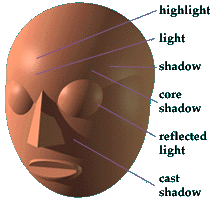 Primer |
Chiaroscuro Applied to the FigureWe can apply the characteristics of chiaroscuro to the face by looking at all the changing planes and by paying special attention to our light source. In the diagram at the upper right hand corner of this page the convention described on the previous page is applied to a group of spheres and a pyramid (nose). If you look at each part of this scene you can pick out six or seven distinct areas: highlight, light, shadow, core shadow, reflected light, secondary highlight, and cast shadow. Some elements to note:
The rest of the figure has similar characteristics. The arms, legs and trunk of the body can be thought of as cylindrical forms which have the same distinct areas of light. Changes in planes cause these amounts of light and shadow to be altered. This link to a Lhermitte drawing of An Elderly Peasant Woman shows how chiaroscuro is applied to the face. The use of texture is equally impressive in this charcoal drawing.
Questions or comments can be forwarded to Ralph Larmann at the University of Evansville. |  This illustration shows how to take a simplified formula like chiaroscuro and apply it to a more complex form. Simplifying the figure into simple geometric parts is a good way to lay out a figure early in the drawing before taking it to a finishing stage.
Another good page on chiaroscuro is at the Art Studio Chalkboard web site.
|

| [Primer] created 6/15/98 by R. M. Larmann |

Custom Search
|